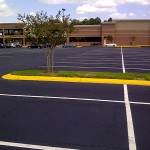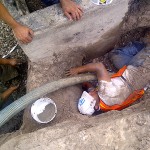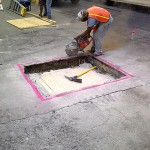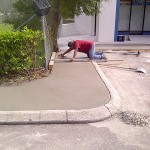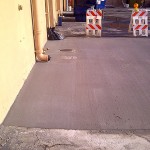
How to ensure your parking lot has proper stormwater drainage.
Asphalt pavement and parking lots often suffer from weather conditions like storms and hurricanes. These can cause your asphalt to deteriorate and eventually form cracks and potholes or other serious problems if they are not properly built. Aside from this, constant wear and tear from vehicles can also cause further damage to your pavement. This is the main reason proper stormwater drainage is so important to the life span of your parking lot.
As a property owner, it is a must to maintain your parking lot. This area speaks volumes about your business and can affect how customers perceive your property, so you want to make sure it always looks its best. To ensure this, you must keep up with parking lot maintenance to manage your pavement, prolong its longevity, and protect it adequately.
Drainage planning is a key step in parking lot maintenance. An efficiently planned drainage system helps prevent flooding and reduces the need for repairs. Check out the information below to guide you in improving your parking lot’s stormwater drainage design. Learn more about proper parking lot drainage, position curbs, and lay out your parking lot so that you can maximize drainage efficiency.
Know the Slopes of Your Parking Lot and Adjust to Them for Proper Stormwater Drainage
When designing your drainage system, you can start by checking out the contour map of your site. A contour map shows the slopes, pits, or flat areas on your property, so you can determine the best locations to install and place your potential drainage equipment. The map will also guide you on how much stormwater a certain area will possibly receive to help you prepare your site adequately.
Having the data from your contour map ultimately allows you to create a larger inlet depending on how much water the base will receive. For severely sloped areas, you might need to install a storm sewer to accommodate the amount of rainfall your asphalt will potentially receive. If your parking lot is flat or does not have a good slope angle, you can reduce water accumulation by installing grate inlets at multiple sites.
Another option you can consider is sloping your asphalt pour, which involves creating a curve steep enough to let the water fall to the sides. This technique is often used on roads and highways to help redirect rainwater into gutters and canals when gravity is insufficient. You can use the same principle to mimic a slope to minimize potential puddling or pooling if your parking lot is relatively flat.
Install Berms or Curbs for Better Efficiency
You can also improve your drainage design by complimenting the slopes and contour of your parking lot with berms or curbs. Having a curb helps create a boundary to direct the stormwater to the appropriate grate or inlet.
If you do not have access to a drainage system, curbs can also serve as runoff into ditches to prevent the accumulation of rainwater or ice in your parking lots. An alternative solution would be to redirect the water onto the grass to be reabsorbed by the soil.
Another application for a curb is for it to double as an inlet. By installing one or more curb opening inlets, water can drain before it reaches the lowest point in your parking lot. Having multiple curbs with inlets also allows you to systematically layout your drainage system to ensure you can maximize drainage while reducing possible pooling at any point.
Place Your Drains and Inlets at Various Strategic Positions
When it comes to positioning your drains and inlets, you might be wondering why these usually look out of place. While their positions may seem awkward, they are meant to be put in places where you expect stormwater to pool. These areas are the best locations to drain stormwater, but they can change over time due to the slopes and eventual degradation of asphalt.
It will be difficult to rely on a few grates per area if your parking lot is on the larger side. Thus, it would be best to also dig small trenches or runoffs to assist in redirecting the stormwater into the proper drain.
One useful technique you can apply to maximize your drainage system is to create a split on an island. Making a split creates a dual-channel drainage system to effectively collect water from two points in your parking lot. If you have an expansive parking lot, you can utilize another technique to connect two or more drainage systems to flow into one large storm sewer.
Know How to Prevent and How to Fix Potholes with Proper Stormwater Drainage
Potholes are a major asphalt problem that require immediate attention. They start to form when water enters through a crack in the asphalt, then damages the structure through repeated contractions and expansions depending on temperature. Over time, the asphalt will cave in and form a pothole.
By knowing about proper drainage in parking lots the moment they appear, you can avoid significant expenses and prevent the problem from worsening. While it might seem complicated to learn, you can easily remember the process with these three steps.
- Clean the Pothole
First, you need to clean the pothole thoroughly. Excessive debris can prematurely breed cracks down the line, so make sure you remove large rocks and other foreign materials like grass or dirt.
- Fill the Pothole with the Appropriate Mix
Next, fill the pothole with your asphalt mix. If your mix needs additional activation agents, add them after you pour in your mix.
- Compress the Pothole and Let it Set
Finally, compact the pothole until it is even and leveled, then allow the mixture to set. Make sure you apply adequate pressure to properly seal the pothole and keep it level with the rest of your pavement.
All it takes is one crack to begin the cycle of potentially forming potholes, so one key prevention technique is knowing how to fill in cracks to remedy the problem before it gets worse. It is much easier and cheaper to fill in one crack than to fill a pothole, so the earlier you can repair the crack, the better. If you are not sure about how to proceed, you can seek help from a professional paving contractor.
Poor drainage can cause your lot to flood, resulting in expensive parking lot maintenance and pothole repairs. If you have no prior knowledge or experience with parking lots, it is natural to feel intimidated about the steps involved in planning your drainage system. However, taking the time to learn will be worth the time and effort.
Designing a drainage requires planning a layout, preparing the right materials, and finding reputable contractors. Before you get started with any digging, make sure you consider the important factors. Things like the weather, temperature, and ground hardness all play a part in how you should best organize your drainage system.
Get Professional Help for Your Drainage Design
Are you still unsure about parking lot drainage or how to fix potholes or how you can properly design your parking lot’s drainage system? If so, we can help you out. Contact ACPLM today at 888-959-9637 to get professional asphalt paving and parking lot maintenance services. Whether you need sealcoating for your pavement or a drainage design for your parking lot, we can find the right solutions for your problems.
Protect your investment today by maximizing the useful life of your pavement. Prevent flooding and pothole formation with a proper stormwater drainage system.









